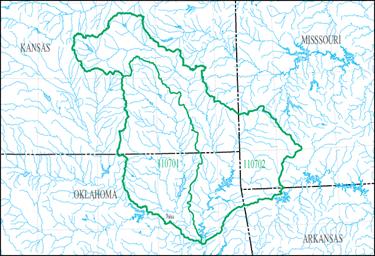


The 40-square mile Tar Creek Superfund Site is located in Ottawa County, a county with a population of roughly 33,000 people, in northeastern Oklahoma. Communities in this Superfund location include Cardine, Commerce, North Miami, Picher, and Quapaw communities.

Location of Ottawa County, Oklahoma
(image source: en.wikipedia.org)
Tar Creek is part of the area known as the Tri-State Mining District; so named because of zinc and lead mining that occurred from the early 20th Century until the 1960’s-1970’s in this region of eastern Missouri, southeastern Kansas, and northeastern Oklahoma.
Tar Creek is located in Ottawa County, Oklahoma. Ottawa County is located in northeastern Oklahoma at the Oklahoma/Kansas and Oklahoma/Missouri borders. Tar Creek Superfund site consists of a forty square-mile area; however, it is part of a larger region known as the Tri-State Mining District that includes areas of Kansas and Missouri, as well as Oklahoma. A substantial amount of the land in the mining area is owned by the Quapaw Tribe; held in trust by the U.S. Department of Interior.
Beginning in the early 1900s, and continuing through the 1970s, this northeastern region of Oklahoma was extensively mined for lead and zinc ore; with this district's lead and zinc production ranking as one of the highest in the world. Milling the lead and zinc ore resulted in a concentrate of the original mined material. However, the milling process for lead and zinc ore also produced waste mile tailings, also known as chat. Over the years, mining companies disposed of chat by creating large aboveground piles, and by dumping it into flotation or tailing ponds. Some chat piles rise as high as 200 feet; all contain elevated levels of lead and other heavy metals.

Images of Chat Material, Oklahoma
(source: www.time.com)
The U.S. Geological Survey and the U.S. Army Corps of Engineers have estimated that Tar Creek generally contains 75 million tons of chat piles, according to the publication Oklahoma Plan for Tar Creek (source: www.cees.ou.edu).
In 1983, the Environmental Protection Agency (EPA) listed the Tar Creek site on the National Priorities List, making it subject to the Comprehensive Environmental Response, Compensation, and Liability Act (also known as CERCLA, or more commonly as Superfund). EPA found that tailings were located throughout residential properties in the Tar Creek Site, with foundations of local homes and business built on chat. In addition to chat, another by-product of the mining operation is highly acidic mine water.

Acid Mine Drainage into Tar Creek at Douthat Bridge
(image source: www.epa.gov)
When the lead and zinc mines were abandoned, they began filling with water. In the late 1970’s, acid mine drainage containing high concentrations of heavy metals began discharging into Tar Creek from natural springs, boreholes, and open mine shafts.

Watersheds in the Tri-State Mining Region (source: water.usgs.gov)
Several public health concerns are presented by the Superfund site, including mine shaft hazards, poor air quality due to lead-laden dust, acid mine drainage, soils contamination associated with chat piles and mine waste, and exposure of children and other susceptible populations to contaminated materials. Additional health risks are associated with consumption of fish and other wild food from the Tar Creek Superfund Site, as well as the Neosho River and Spring River watershed. All of these environmental and human health concerns are being examined by the EPA, the Department of Human Health and Services, and other state and local agencies.
In 2003, three federal agencies, the Environmental Protection Agency (www.epa.gov), Department of Interior (DOI), and U.S. Army Corps of Engineers, signed a Memorandum of Understanding (MOU) that facilitates cooperation of the agencies to bring a holistic response to the risks posed at the Tar Creek Superfund Site. These agencies bring unique authorities and response capabilities to the ongoing health, safety and environmental risks associated with the Tar Creek Superfund Site.
Federal, state and private efforts are coordinated by the Oklahoma Department of Environmental Quality (DEQ) so that a comprehensive, holistic solution for the environmental and health problems in the area can be developed and implemented.
Many local tribal governments are pursuing additional solutions to restore their lands and protect the health of their members.

Tar Creek Superfund Site (source: www.cees.ou.edu)
Local Environmental Action Demanded (L.E.A.D.) Agency, Inc. (leadagency.org) serves to educate the general public in the Tar Creek area. Their outreach efforts are supported by the Ottawa and Seneca/Cayuga Tribes, as well as environmental department professionals of the Cherokee, Eastern Shawnee, Wyandotte Nation and Quapaw Tribe in Oklahoma.
October 2005
Currently, the TOSNAC Program is working with L.E.A.D. Agency on the following issues:
Tar Creek Superfund
General Water Quality and Watershed Data
Tar Creek Superfund Water Quality and Watershed Data
Local Native American Tribes and Communities
Federal and State Agencies
Human Health
NOTE: The EPA TOSC and TOSNAC programs have ended. Communities seeking technical assistance should contact:
- Karen Martin at EPA Headquarters at 703-603-9925, Martin.Karenl@epa.gov; or
- EPA personnel identified at the bottom of the TOSNAC Information Contacts below:
Brenda Brandon
TOSNAC Program Manager
E-mail: brendabrandon@msn.com
Voice: 785.749.8498 OR 785.532.6519
Mailing addresses
Haskell Environmental Research Studies Center
155 Indian Ave., Box 5001
Haskell Indian Nations University
Lawrence, KS 66046
OR
Center for Hazardous Substance Research
104 Ward Hall
Kansas State University
Manhattan, KS 66506-2502
Earl Hatley
L.E.A.D. Agency
Grand Riverkeeper, Waterkeeper Alliance
E-mail: earlhatley@neok.com
  Privacy, Accessibility, & Tools Privacy, Accessibility, & Tools |
©
The Center for Hazardous Substance Research Last modified October 13, 2009 |